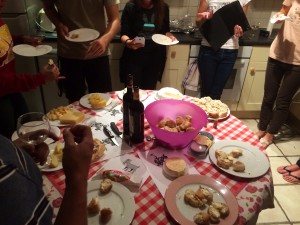Tonight was the night of our wine and cheese tasting lesson in the CEA Study Abroad office. Let me start off by saying that our program coordinator, Kristin, is pretty much a one-woman show and plans everything on her own. She’s taken us on the most amazing excursions right around our area, and is constantly sending us useful information. She’s always available for help with anything from planning a trip itinerary, to manually letting us into our apartments because we haven’t gotten used to our French keys yet…(had to ask for a friend, OK). So, you could say that I knew tonight’s lesson would kill it, both academically and gastronomically.
Not one of the 16 chairs arranged in the circle around the office was left empty, because let’s be real, what kind of a monster passes up free food? To take a page from the ever-wise Ratatouille, “Good food is like music you can taste, color you can smell. There is excellence all around you. You need only to be aware to stop and savor it.” No need to tell us twice.
My friend, Gaby, and I had gone on a run immediately prior to the event, and I was distinctly aware of this fact as we all sat elbow-to-elbow awaiting the start of the lesson (we totally blamed it on the cheese).
 |
| All the wine and cheese provided by CEA |
Kristin gave us our first glass of wine, as well as informational packets to follow along with, because she thinks of everything. This first sample was pale and delicate and local to the Provençale area. Because ‘Wine Connoisseur’ is evidently yet another entry in Kristin’s vast skill set, she gave us a brief history and introduction to wine tasting.
We were first instructed to hold our wine glasses by the stem, and to make note of the color of the wine, which can tell you about its age, concentration, and where the grapes come from. Young white wines are a light straw or golden color, such as the one we were about to taste, and become a deeper yellow with age, eventually turning amber. If the wine is lighter or less intense in color, chances are the grapes are from a cooler, northern climate, as grapes from warmer, southern climates tend to produce more intense hues. Wines of a higher quality also tend to be more concentrated in color, as the wine itself is more concentrated, being made with grapes that have been picked at optimum ripeness. The level of transparency can also be indicative of its quality, as modern winemakers now try to make their wine as reflective and transparent as possible, as is the preference of present-day consumers.
After we had analyzed the color, intensity, and transparency, it was time to smell the wine. Kristin told us to stick our noses directly in. “Take a few small sniffs rather than one huge one. This is called the first nose, and will give you the first aromas, otherwise known as the volatile ones, which escape from the wine most easily. When thinking about what you smell, don’t get too technical – only wine snobs do that, “ she explained with a smile. So which notes did we pick up on, which flavor families were most prominent? One person offered citrus. Another felt that it smelled a little fruitier.
 |
| Kristin teaching us about red wine |
This time, Kristin had us swirl the wine around the glass, then take a few more small sniffs. She explained that this motion aerated the wine, allowing it to release its other, less volatile, aromas. She informed us that wine often smells nothing like grapes, so we shouldn’t be afraid to free-associate the scents of our drink with memories of aromas we’d come across throughout our life, like leather or vegetable smells. These scents can tell us a lot about the wine, and combined with our analysis of its color, can help us to put together its profile. For instance, if we were to detect off-odors like rotten apples or vinegar, or sweet smells like port or madeira, we would know that the wine either had a defect or had been oxidized. A wine that has a lot of scent families represented would be considered of high quality. Leather or animal smells might be indicative of an older wine, while vanilla or caramel might be a hint that the wine had been aged in oak barrels.
Finally it was time to actually taste the wine. It wasn’t as simple as taking a few sips, though; for once in our lives, we were encouraged to slurp our drinks. “This”, Kristin explained, “aerates the wine once again, releasing even more aromas”. Next, we were instructed to “chew” the wine, so that it reached every part of our mouths, and then, to swallow it. You may be wondering how it’s possible to smell aromas better through your mouth than through your nose, and believe me, we were wondering the same thing. We learned that the mouth actually has a much more direct route to the smell receptors than our nose does, and that this effect, called retro-olfaction, is crucial to the wine-tasting process. We were informed that if the aromas we found with our mouth were similar to the ones found with our nose, that was a sign of a well-made wine, and vice versa.
At this point, we had all settled back into our seats, thinking smugly to ourselves that our wine-tasting lesson was done and we knew all there was to possibly know on the matter. Wrong. Now came the time to analyze the tastes of the wine!
 |
| Everyone enjoying the wine tasting |
In whites, like the one we were enjoying, there are three main taste components: acidity, alcohol, and “moelleux” or “gras”, which is the fatness/richness/smoothness. Red has these same three components, as well as a fourth, called astringency. The acidity of the wine will resonate on the sides of your mouth on either side of your tongue, at your salivary glands. If your wine has a good acidity, you will salivate. The alcohol brings a sensation of heat to your mouth and throat. The fatness of the wine is a feeling of unctuousness, roundness, and fullness in your mouth. Finally, astringency has a light, dry feeling – it is a pungent, puckering quality felt mainly in the middle of your tongue, as well as in your cheeks. The most important thing to keep in mind when tasting wine is the balance between these 3 or 4 elements, as no one taste will dominate in a good quality wine. They will enhance each other rather than fight each other.
Finally, there comes the last portion of the tasting – the evaluation. For this part, Kristin had us repeat the process of sipping the wine, slurping it, chewing it, and swallowing it. As soon as the wine had left our mouths, we were told to try and determine how long we were able to perceive the aromas, (not tastes), of the wine. Just like how you count the seconds that pass between hearing a rumble of thunder and seeing a flash of lightening, we counted the seconds it took until we were no longer able to perceive the aromas of the wine. This is called the persistence. In well-made wines, the aromas will linger for many seconds after the wine has left your mouth. If the aromas of your wine only last about 4 seconds, its persistence is considered to be “short”; 4-6 seconds is regarded as “medium”, and 7-12 is “long”.
We were in awe. I now understood why wine-tasting was considered an art! That process tired me out even more than my entire workout had. With valuable knowledge, newfound cultural appreciation, and a certain amount of adopted snobbery added to our inventory, we eagerly moved on to the cheese-tasting course, where we stuffed our faces without a thought in the world.
Charlotte Walker is the Fall 2014 CEA MOJO in French Riviera. She is currently a Junior at Northeastern University.










